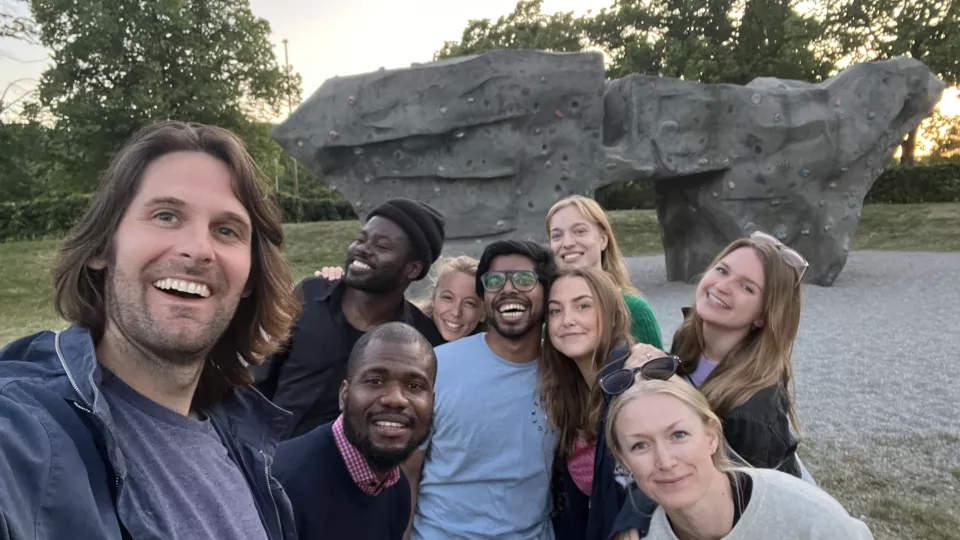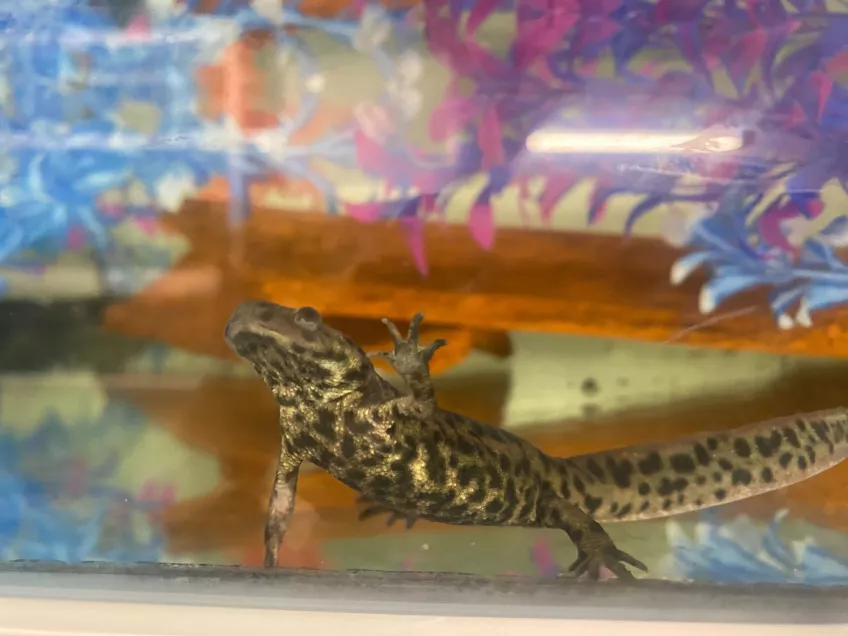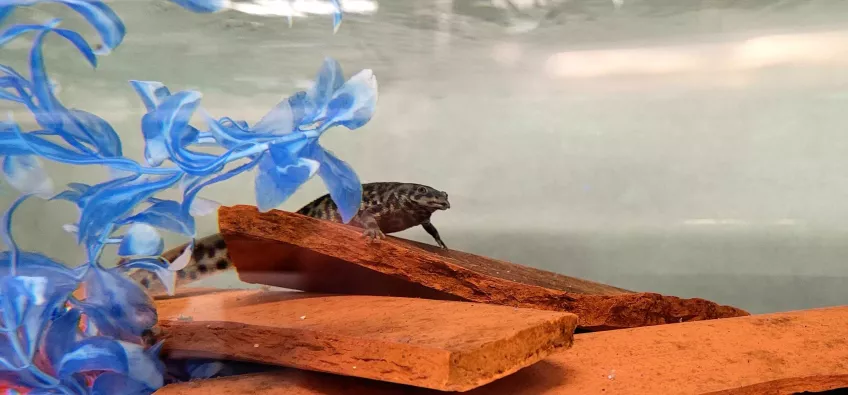Warm welcome Nick to the second edition of the WCMM Fireside Chat series. First, could you explain a bit your research area, especially for the ones who are not familiar with it?
"We are focused on understanding how certain animals, like salamanders, can regenerate complex tissues, like arms and legs! Arms and legs are made up of many types of tissues, like bone, muscle, and tendons, so it’s quite impressive that a salamander can put these back together without issue in the correct orientation and size. This is obviously a lot different than what happens if a human loses a limb, we are stuck without that limb the rest of our lives. In essence, our work is trying to understand why salamander can regenerate limbs, but also why humans can’t. We think a key to this difference could be how the immune system responds to injury. While we usually think of the immune system when we talk about viruses or bacteria, it also plays a critical role in tissue regeneration. Striking the right balance after an injury is essential and it seems the salamanders have a recipe for success in this regard."
How fascinating! How did you become interested in this topic?
"I’ve always been fascinated by antler regeneration in deer, moose, and elk. How can these massive bones be created every year of their lives?!? Not to mention they are bilaterally symmetrical and super strong. This was something I was fascinating with growing up when I’d find these antlers on hikes in the mountains. As I got a bit older, I realized this wasn’t the easiest model system to work with experimentally and I really was still interested in regeneration. After doing a PhD in Immunology, I felt I needed to jump headfirst into the field of regeneration and that limb regeneration was almost as interesting as antler regeneration, but I could have a lab was manipulating the system experimentally."
Although using salamanders as a model to work with and manipulate experimentally seems easier than deer, moose, or elk, it does seem as well challenging to use such a "non-traditional" model system for research. What are your research questions and how do you tackle them?
"We are focused on characterizing regeneration processes using a simple approach. First, we investigate what is going on during regeneration, mainly by looking at cells and how they are behaving. Then we work to either remove these cells or modify their behavior and see if that affects regeneration. Right now, is the best time to be studying non-traditional model organisms, like salamanders, because we have amazing technologies at our hands to let us do exactly this two-step approach. There are a lot of incredible sequencing technologies now that have let us characterize the regeneration processes at a level that we couldn’t have imagined just 10 years ago. This is coupled with the discovery of CRISPR which is now letting us quite easily influence cells and their functions. This allows us to do a full circle experiment where we characterize, perturb the system, and then can characterize the perturbation, leading to a nuanced view of the process of regeneration and its requirements.
Your plan seems very straightforward to untangle the mysteries of regeneration, but behind the scenes I believe that this has been a laborious journey. What are you most proud of achieving so far?
I am really proud of our recent publication that was led by a postdoc in the lab, Dr. Joe Cardiello. These techniques that we need to characterize the processes of regeneration are still being refined and we don’t always know the best way to use them. Joe was able to show a much-improved way of conducting these sequencing/characterization experiments in which we are able to study many animals in parallel. This gives us much more confidence in our experiments because we can find aspects of regeneration that are happening in all of the animals we study and not just one or two. For us, this has completely redefined how we can do experiments and the really cool part is that this holds true for (almost) all species. This means that this approach can be quite ubiquitous in helping researchers do better experiments, not wasting time on false leads and thus increasing efficiency which in the long run should also decrease the number of animals used in research. It will be hard to beat this paper in regard to being so broadly impactful in terms of changing how people can think of experimental design in so many different species.
Congratulations to you, Dr. Joe Cardiello and the team for publishing such an important article which shows how to push the boundaries of sequencing technologies making them broadly applicable to other species! Now that this important piece of work is done, what are the next steps and what are you looking forward to?
"The first few years in my lab have been a lot of setting up and this has been particularly challenging since we established a new salamander facility at Lund University. This means we are now starting to get things moving in the way that I envisioned when I started 3.5 years ago! As I mentioned before, we are now able to test how cells are influencing regeneration and this is what I’m most excited about moving forward. See how elimination of cells or changing their behavior after injury influences regenerative outcomes. We also have some really interested data on how regeneration and cancer processes are intertwined. You may be surprised to hear that salamanders are highly resistant to tumor formation. What could be better…the ability to both regenerate limbs and not get cancer! We think that these two features are not just a coincidence, but rather may be related and that’s what we are seeking to find out."
We are really looking forward to the upcoming findings from your group and are excited about attending upcoming seminars and presentations given by you or any of your group members to follow your progress. Since you established now successfully your group, a new salamander facility at Lund University and the technology required to collect and analyze data from non-traditional models such as salamanders, which challenges are you and maybe even others in the field now facing to unravel the role of distinct cells or proteins in regeneration?
"We are swimming in data and the main challenge is finding out what datasets and findings are relevant. It’s much easier to create data than it is to test hypotheses using loss-of-function experiments. We and others are faced with the challenge of separating the signal from the noise. That is, making a functional understanding of a process. Nowadays, it’s really easy to say we have these cells in the regenerating limb, and they are expressing these particular proteins, but without an experiment that eliminates those proteins from those particular cells, we don’t actually know if that matters or not! Doing this is scale is what we are grappling with now, how do I test the role of 50, 100, 1000 different proteins? This is one of the reasons we are so excited about using CRISPR as doing massively parallel CRIPSR screens where we test many hypotheses in one experiment are now possible!"
We wish you and all your collaborators all the best for your experiments and adventures of finding the true key players in regeneration! As a last question, how much did it help you to be a WCMM fellow in Lund?
"Being a WCMM Fellow has been instrumental for me in getting settled in Sweden. When you come from abroad to start your lab, you do not know anyone, and you don’t know anything about the University! I was the 10th hire in this program at Lund and thus have benefited a ton in terms of coming into a cohesive and collegial network of colleagues at a similar career stage. It’s quite unique to have such a large cohort of new PIs at an institute and I think this has led to a strong feeling of belonging in the WCMM! We are all dealing with similar growing pains of starting our labs, many of us moving to a new country, and all at the same time trying to do great science."
Thank you in the name of the WCMM communication team for this wonderful interview and I believe many of us understand now much better your research area, your background and future path and we wish you all the best for future discoveries.




